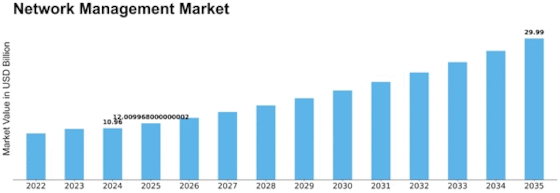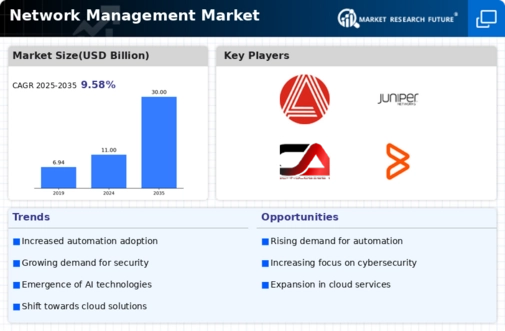Network Management Size
Network Management Market Growth Projections and Opportunities
The Network Management market is experiencing rapid growth as businesses become increasingly reliant on complex networks to support their operations. With the rise of cloud computing, IoT devices, and remote work, effective network management has become crucial. In this competitive landscape, companies are employing various market share positioning strategies to differentiate themselves and capture a larger market share.
One common market share positioning strategy in the Network Management market is product differentiation. Vendors strive to develop unique features and capabilities that set their network management solutions apart from competitors. This could include advanced analytics and reporting capabilities, AI-powered automation, or integration with emerging technologies like SDN (Software-Defined Networking) or NFV (Network Function Virtualization). By offering innovative functionalities, companies can position themselves as leaders in the market and attract customers who prioritize specific features.
Another important strategy in the Network Management market is target market segmentation. Vendors identify specific industries or verticals that have unique network management needs and tailor their offerings accordingly. For example, companies may develop specialized solutions for healthcare, finance, or manufacturing sectors. By understanding the specific challenges and requirements of different industries, vendors can position themselves as experts in addressing those needs and gain a competitive advantage.
Price positioning is also a crucial factor in market share positioning within the Network Management market. Some vendors choose to compete on price, offering affordable network management solutions to attract cost-conscious customers. This can be effective in gaining market share, especially in price-sensitive markets. On the other hand, some companies position themselves as premium providers, offering high-end network management solutions with advanced features and scalability. This approach appeals to customers who prioritize performance and are willing to invest in robust network management capabilities.
Partnerships and collaborations are another effective market share positioning strategy in the Network Management market. By partnering with other technology providers or network equipment manufacturers, vendors can expand their reach and leverage their partners' customer base. Integration with popular networking devices or platforms can provide vendors with a competitive advantage and increase their visibility in the market. Furthermore, collaborations with complementary technology providers can lead to joint marketing efforts and strengthen the overall market position of network management vendors.
Effective marketing and branding are crucial in market share positioning within the Network Management market. Vendors invest in creating compelling marketing campaigns that highlight the benefits and advantages of their network management solutions. This includes thought leadership content, case studies, and customer testimonials that demonstrate the value and ROI of their products. By building a strong brand reputation and establishing thought leadership, network management vendors can differentiate themselves from competitors and gain market share.










Leave a Comment